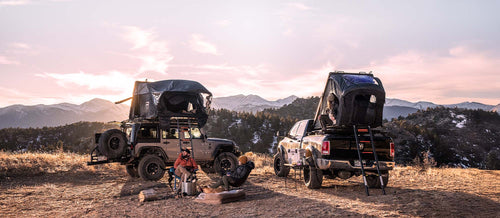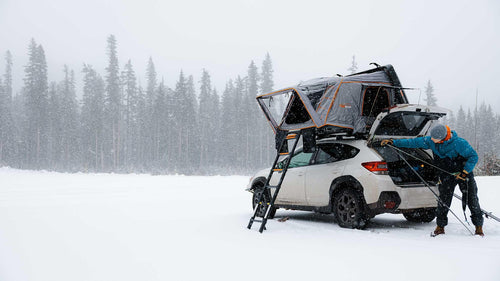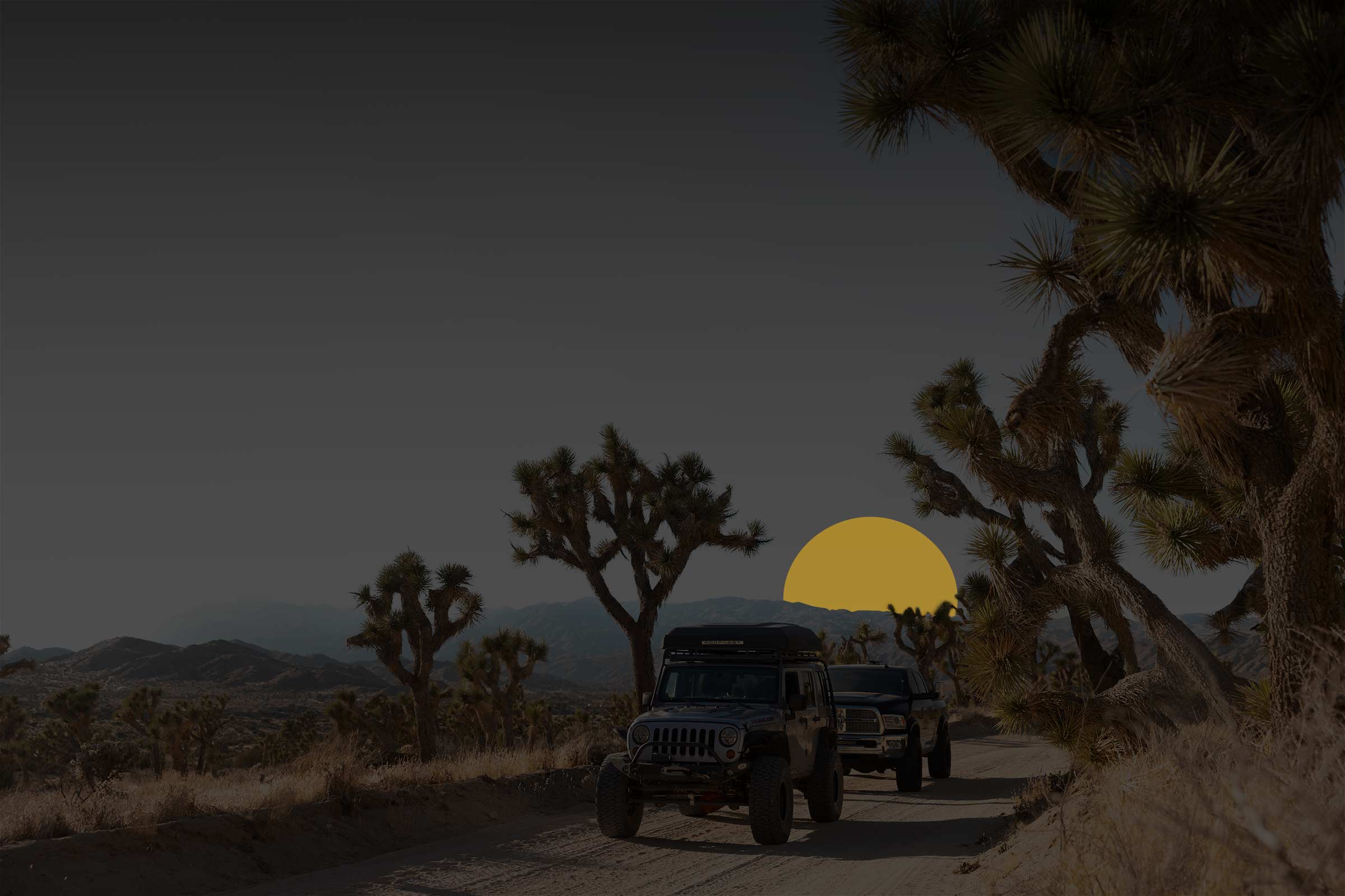It is easy to become overwhelmed with the relentlessness of everyday life. Deadlines, traffic, the ceaseless noise of the city. This is why we vacation. This is why we build vehicles designed specifically to escape into the most remote wilderness. There is serenity in the calmness of the forest, the quiet rush of water in the river down the way. There is peace in the vastness of the desert and the soft wind brushing against the tent walls. And finally, there is a special kind of awe and wonder from looking into the stars on a truly dark night. Humans barely get to experience the true wonder of the night sky thanks to ever expanding light pollution.
If you have even a passing interest in the vast and unknowable beauty of our universe, you owe it to yourself to make 2024 the year you plan an astro camping trip. There are tons of spectacular astronomy events happening this year, including the last total solar eclipse in the US for the next 20 years.
Where should you camp?
The first step in planning your astronomy camping vacation is finding a place to set up shop. Here at Roofnest we have spent plenty of time covering the best ways to find camping spots in general. For comfortable and dependable shelter, consider our roof top tents collection, designed for easy setup and durable protection wherever you go.

For now we are going to look at finding the best places for stargazing by avoiding light pollution. The enemy to any stargazing journey is light. Some of our cities have gotten so bright that their glow can be seen from dozens of miles away. To find our perfect campsite we need to combine our tools from above with some special light pollution maps. National Geographic has a great map that shows what light pollution in the US looks like from space. This is a great tool to get a general idea on how far away from your city you need to get to find real darkness. One of the big takeaways is that folks living out west will have an easier time than any of the east coasters outside of rural New England.
Once you have some general areas picked out, you can use a more precise map like this one to better gauge how dark your skies will be. With these tools you can easily find a campsite with dark skies and amazing views.
If you just want some quick suggestions on places to start with readily available camping, we have some of those for you as well. For those on the East coast, Shenandoah National Park is a solid choice, and if you head across I-81 to Spruce Knob-Seneca Rocks National Recreation Area you’ll find even darker skies, but it is less convenient to get to. Acadia National Park and much of the Adirondack mountains are also great choices. Finally, if you don’t mind fighting bugs and wildlife, the Everglades get properly dark at night if you get far enough away from the Miami side of the park.
For those in the Midwest, once you get west of I-29, you can find a lot of open dark sky. For those farther south, the Ouachita National Forest just south of the Ozarks in Arkansas is a solid choice. For the rest of you folks out west, you have plenty of options. Outside of the largest cities like LA, Phoenix, Denver, Boise and the like, you can find a lot of wide open space with dark skies. That said, for our money the eastern side of Joshua Tree National Park or the mountains around Crested Butte in Colorado are hard to beat.
What basic items should you take with you?
Now that we have talked about where to camp, let’s go over some of the extra equipment you may want to take with you. Don’t get too scared, you won’t need a whole pile of gear to enjoy a great night sky, but depending on what specifically you want to see, there are a few things that could give you a better experience.
Let’s start off with some of the obvious stuff that you maybe didn’t think about, like chairs and lights. Standing up and staring at the sky for an hour can cause you some serious neck pain, so maybe consider a chair that reclines. Another great option is a hammock, so you can just lay back and gaze at the sky above you. If you want stargaze while laying in bed, check out the Roofnest Falcon 3 EVO Air. This tent features a large skylight window in the top of the tent, making it perfect for watching the stars spin overhead while cuddled up under a nice blanket.
Next up, having the right light can make or break a good stargazing session. Inevitably you are going to need to go looking for something, and you will need some light. The problem is it can take your eyes as long as 30 minutes to fully adjust to a dark night. If you are turning on a bright flashlight, or even your phone screen, it can spoil your dark vision. Instead look for headlamps with red light features. Red light specifically doesn’t affect the parts of your eye needed for seeing when it is dark. And when it comes to your phone make sure you have the brightness all the way down and activate any sort of dark mode you may have. Finally, it can help to hold to phone as far away from your face as possible, and at a slight angle pointing left or right away from your face.
One last tip, turn off the automatic dome light in your car. Nothing is worse than running to the car for a quick beverage or blanket, only to blind yourself with a dozen interior LED light bulbs. Trust us. Also consider adding a Puffy Camp Blanket to keep warm without giving off unwanted light.
Finally, don’t forget warm clothing. Even in the middle summer it can get cold on a clear night, especially out in the desert. You won’t have a fire because you want to limit light, so make sure you have a good coat or spare blanket handy.
What about telescopes and stuff?
You can enjoy a vast majority of the night sky without any special equipment. From meteor showers and constellation spotting to planetary alignments or just experiencing the majesty of the Milky Way all you need is two eyeballs. But if you want to get a closer look at our solar system or peek even deeper into space some extra equipment can make it happen.
On the cheap end, you can grab yourself a good pair of powerful binoculars. With a standard pair of binoculars you can get a closeup view of the craters on the moon, or even potentially view the rings around Saturn. If you want the best experience there are special astronomy binoculars with much higher levels of magnification. You can find lots of options for less than $100. If you have a night that is clear enough and dark enough this is all you would need to be able to glimpse our closest neighbor galaxy, Andromeda.
If you want to step things up a notch and get a better look at our solar system or glimpse at things even farther out like nebulas, you can grab yourself a telescope. These will require a little extra setup and effort to use, but you can see even more of the majesty in the sky. For less than $150 you can grab a good beginner telescope like this one from Celestron. With this you can get a great view of Jupiter, easily see the rings around Saturn, and even spy some spy cluster formations like Pleiades or glimpse the Orion nebula.
Finally, if you really want to experience all the majesty available in the depths you can invest in a smart telescope with a built-in camera sensor. With a telescope like this you have built-in GPS location tracking and tripod movement. You can just tell the telescope what you want to see and it will find it for you. With the digital camera sensor these kinds of telescopes can also take multiple long exposure photos to help you see objects that are so faint and distant that you can’t see them with your eyes alone. These don’t come cheap, with our least expensive recommendation being the $2500 Unistellar Odyssey, but they provide a special kind of experience you can’t achieve with anything else small and portable enough to take camping.
How do I know what to look at?
If you are not familiar with the night sky, we recommend checking out star charts or for the best experience use a stargazing app. These use your phone GPS to locate you and give you an accurate and up to date map of what is in the sky above you. They can point out planets and constellations while also revealing the location of deep space objects like galaxies and nebulas. If you have a telescope and want to know where to point it, these apps will get you headed in the right direction.
Don’t forget about the light though. We recommend firing up the app when you first get setup just to orient yourself with what stars and planets are visible to you. Then once you know what’s up there, you can put the phone down and let your eyes start adjusting while you set up your telescope or chairs.
When are the special astronomy events to watch?
We’ve covered where to go and what gear you need, now for the good stuff. What should you go looking for in that sky, and what are the astronomy events you can’t miss in 2024?! While there is no wrong time to go stargazing, these are some of the most important and interesting astronomical events for the year.
April 8th, 2024 – Total Solar Eclipse
First we have to start with the big astronomy event of the year, the 2024 total solar eclipse. The US was blessed with an amazing total solar eclipse in 2017, and we had a near total annular eclipse last fall, but this April we will be getting another great total solar eclipse that will cut clean through the United States. The path starts in Texas and carves a northeastern path up to Maine. This path takes it right over major cities like Austin and Dallas, as well as Indianapolis, Cleveland, and Buffalo. That means there is a lot of wide open land to find a good camping spot. Because, one of the benefits of a total solar eclipse is that it happens during a new moon. So once you experience the solar eclipse during the day, you will also be rewarded with a perfectly moonless and dark night sky. The Sombrero Galaxy and Whirlpool Galaxy should both be visible with the right equipment.
More importantly however, this is the last total solar eclipse in the United States for more than two decades. The next chance to view a total eclipse on US soil is a small area of northern Montana in 2044, with an eclipse in 2045 that will cross the United States like the 2017 eclipse did.
Early May – Eta Aquarids
If you want a nice reason to camp in the spring, early May sees the arrival of the ETA Aquarids meteor shower. This meteor shower is caused by remnants from the tail of Halley’s comet. The meteor shower takes place from April 19th until the end of May, but the best time to see the show is around May 6th. This is close to the new moon, so the dark skies should let you see as many as 60 meteors an hour.
June and July – Experience the Milky Way
The largest and most impressive thing in our night sky, the Milky Way galaxy that earth calls home, is most visible through the middle of the summer. During the months of June and July this astonishing blanket of stars can be visible for upwards of five hours or more as it swings across the night sky. The best times to see are around the darker phases of the moon. This year, try to plan your camping trip around the first week of June, the end of June into the first two days of July, and finally the last week of July leading into August.
Mid August – Perseids Meteor Shower
As summer comes to end and the long days begin fading into earlier nights, you can catch one of the most active meteor showers of the year. The shower technically runs from the end of July until the end of August, but the most active and brightest meteors will come around August 11th. Like the Aquarids earlier in the year, you can expect as many as 60 meteors or more per hour, but the Perseids are famous for producing some of the brightest and most defined meteors in the night sky. This is mid moon cycle so you won’t have truly dark skies until after midnight when the moon sets, but if you can stay up late enough this is a show you don’t want to miss.
September 8 – Saturn at Opposition
If you want to get the best look possible at Saturn, this is the night to do it. Planetary opposition is where the planet is at its closest approach to earth and is exactly opposite the sun from our position. This makes the planet appear brighter and more clearly than any other night of the year. A good pair of binoculars will let you glimpse the rings, and a decent telescope will show them off with remarkable clarity.
November 15 – Supermoon
While there will be multiple supermoons throughout the year, we think this one in November will be the one to plan a camping trip around. Typically we avoid full moons so that we can see the rest of what the galaxy has to offer, but early winter sees us in a period where most of the deep sky objects of note are only visible in the wee hours of the morning, so why not take some time to enjoy the majesty of our local moon at its biggest and brightest.
December 7 – Jupiter at Opposition
To end the year, take a glimpse up at our solar system's largest celestial body. Just like with Saturn earlier in the year, on this night Jupiter will be close to earth and perfectly lit by the sun. You should be able to easily see the planet and some of its largest moons with just a pair of binoculars. With a decent telescope you can spot details in the cloud bands that swirl around the planet's surface.




